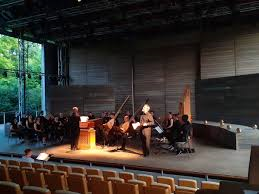Royal Albert Hall, 25 July 2019
The evening began with a crisp but warm account of Till Eulenspiegel. There’s something about the acoustic of the Royal Albert Hall and the raked positioning of the orchestra which helps to bring out the detail and colour both melodically and dynamically. The trumpet solo and a couple of contrabassoon entries added noticeably to the spiky drama here, for example.
Stenz is a baton-less conductor with unusually expressive wrists and fingers which he uses balletically to coax what he wants from his players. In the familiar pieces which opened and closed this concert he used no score and rarely did anything as prosaic as beating time.
It was different, though in the trumpet concerto by Swedish composer Tobias Brostrom – played here in the UK for the first time. Stenz used a score and conducted more conventionally as you’d expect in music which is new to every orchestral player. There was a different sort of concentration and tension. The piece is structured in two halves but three broad sections with the middle “movement” equating approximately to a traditional concerto adagio. The other-worldly percussion in the first section was impressive as the two solo trumpets (Jeroen Berwaerts and Hakan Hardenberger), mostly in thirds or echoing canon, played their haunting rather than melodic parts. It wasn’t a piece which I warmed to particularly although this orchestra played it well and both soloists did a fine job.
And so to the safety of Brahms’s first symphony which Stenz delivered with cohesion and colour especially in the andante which brought some really beautiful work from guest principal oboist, Chris Cowie and from Philippe Schartz on trumpet. The pizzicato passages were as vibrant and pointed as I’ve ever heard them and the finale (Stenz by now in whole arm, windmill mode) was both grandiloquent and moving.
Well done, BBC National Orchestra of Wales. It was a pleasant concert and what a sensible decision on the second hottest London day on record to play in shirtsleeves and tie-less.
Susan Elkin

